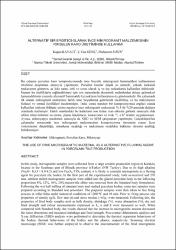Alternatif Bir Ergitici Olarak İnce Mikrogranit Malzemesinin Porselen Karo Üretiminde Kullanımı
Künye
Kayacı, Kağan, Ş Can Genç ve Muharrem Uzun." Alternatif Bir Ergitici Olarak İnce Mikrogranit Malzemesinin Porselen Karo Üretiminde Kullanımı." AKÜ Fen Bil. Dergisi, Özel Sayı (2009) : 117-123.Özet
Bu çalışma porselen karo komposizyonunda ince boyutlu mikrogranit hammaddesi kullanımının etkilerini araştırmak amacıyla yapılmıştır. Porselen karolar düşük su emmeli, yüksek mekanik mukavemet gösteren, az leke tutan, sırlı ve sırsız olarak iç ve dış mekanlarda kullanılan ürünlerdir. İstenen bu özelliklerin sağlanabilmesi için son zamanlarda ekonomik nedenlerden dolayı geleneksel hammaddelerin yanında alternatif hammadde kaynakların kullanılması da gündemdedir. Bu çalışmada ilk olarak mikrogranit malzemesi farklı tane boyutlarına getirilerek inceltilmiş ve bu malzemenin fiziksel ve termal özellikleri incelenmiştir. Daha sonra standart bir komposizyonda ergitici olarak kullanılan sodyum feldspat yerine reçeteye ince mikrogranit malzemesi % 8 ile %20 arasında değişen oranlarda katılmıştır. Farklı oranlardaki bu katkıların son ürüne olan etkisini görmek amacıyla elde edilen nihai ürünlere su emme, pişme küçülmesi, mukavemet ve renk “L a b” testleri uygulanmıştır. Ayrıca, mikroyapıyı incelemek amacıyla da XRD ve SEM çalışmaları yapılmıştır. Gerçekleştirilen çalışmalar sonucunda ince mikrogranit malzemesinin komposizyona ilavesinin camsı fazın viskozitesini düşürdüğü, sinterleme sıcaklığı ve maksimum sıcaklıkta bekleme süresini azalttığı belirlenmiştir. In this study, microgranite samples were collected from a large ceramic production region in Karakoy located in the Southeast part of Bilecik province inTurkey (NW Turkey). Due to its high alkaline (Na2O+ K2O ~ 8.0-8.5) and low Fe2O3, TiO2 content, it is likely to consider microgranite as a fluxing agent for porcelain tile bodies. In the first part of the experimental study, both as-received and 270 min. attrition milled microgranite samples were added into the glazed porcelain body in the following proportions 8%, 12%, 16%, 20% meanwhile albite was removed from the Standard body formulation. Following the wet ball milling of standard body and studied porcelain bodies, some test samples were prepared according to Standard test procedure. The prepared samples were then taken to fast firing process in roller kilns under industrial conditions of 1200 °C and 49 min. Prior to firing process slip properties of density (g/l), flow rate (s) and sieve residue (+63 p) were measured. Following this, the properties of fired body samples such as bulk density, shrinkage (%), water absorption (%), dry and fired strength and colour measurements expressed as L, a and b were measured as well. When compared with Standard body, the results showed that the increase in microgranite amount decreased the water absorption and increased shrinkage and fired strength. Non-contact dilatometric analysis and X-ray diffraction (XRD) analysis were performed to determine the thermal expansion behaviours of the bodies, thermal behaviours of the bodies and the phases, respectively. Scanning electron microscope (SEM) was further employed to observe the microstructure of the fired microgranite samples with respect to firing temperature. Moreover after firing process under industrial conditions quartz, plagioclase and mullite phases were detected in the bodies as the main phases. Based on these analyses and observations made during this study, it has been concluded that very fine grained microgranite material can be used in glazed porcelain tile bodies as a very good fluxing agent which leads to the suggestion that the removal of albite taken from £ine-Aydm region from the body recipe can be taken into consideration.
Kaynak
Fen Bilimleri DergisiSayı
Özel SayıBağlantı
http://hdl.handle.net/11630/783Koleksiyonlar
- Özel Sayı [38]



















